
Page 23
http://threesology.org
Note: the contents of this page as well as those which precede and follow, must be read as a continuation and/or overlap in order that the continuity about a relationship to/with the typical dichotomous assignment of Artificial Intelligence (such as the usage of zeros and ones used in computer programming) as well as the dichotomous arrangement of the idea that one could possibly talk seriously about peace from a different perspective... will not be lost (such as war being frequently used to describe an absence of peace and vice-versa). However, if your mind is prone to being distracted by timed or untimed commercialization (such as that seen in various types of American-based television, radio, news media and magazine publishing... not to mention the average classroom which carries over into the everyday workplace), you may be unable to sustain prolonged exposures to divergent ideas about a singular topic without becoming confused, unless the information is provided in a very simplistic manner.
Hidden variables A fundamental concept in quantum mechanics is that of randomness, or indeterminacy. In general, the theory predicts only the probability of a certain result. Consider the case of radio-activity. Imagine a box of atoms with identical nuclei that can undergo decay with the emission of an alpha particle. In a given time interval, a certain fraction will decay. The theory may tell precisely what that fraction will be, but it cannot predict which particular nuclei will decay. The theory asserts that, at the beginning of the time interval, all the nuclei are in an identical state and that the decay is a completely random process. Even in classical physics, many processes appear random. For example, one says that, when a roulette wheel is spun, the ball will drop at random into one of the numbered compartments in the wheel. Based on this belief, the casino owner and the players give and accept identical odds against each number for each throw. However, the fact is that the winning number could be predicted if one noted the exact location of the wheel when the croupier released the ball, the initial speed of the wheel, and various other physical parameters. It is only ignorance of the initial conditions and the difficulty of doing the calculations that makes the outcome appear to be random. In quantum mechanics, on the other hand, the randomness is asserted to be absolutely fundamental. The theory says that, though one nucleus decayed and the other did not, they were previously in the identical state. Many eminent physicists, including Einstein, have not accepted this indeterminacy. They have rejected the notion that the nuclei were initially in the identical state. Instead, they postulated that there must be some other property—presently unknown, but existing nonetheless—that is different for the two nuclei. This type of unknown property is termed a hidden variable; if it existed, it would restore determinacy to physics. If the initial values of the hidden variables were known, it would be possible to predict which nuclei would decay. Such a theory would, of course, also have to account for the wealth of experimental data which conventional quantum mechanics explains from a few simple assumptions. Attempts have been made by Broglie, David Bohm, and others to construct theories based on hidden variables, but the theories are very complicated and contrived. For example, the electron would definitely have to go through only one slit in the two-slit experiment. To explain that interference occurs only when the other slit is open, it is necessary to postulate a special force on the electron which exists only when that slit is open. Such artificial additions make hidden variable theories unattractive, and there is little support for them among physicists. The orthodox view of quantum mechanics—and the one adopted in the present article—is known as the Copenhagen interpretation because its main protagonist, Niels Bohr, worked in that city. The Copenhagen view of understanding the physical world stresses the importance of basing theory on what can be observed and measured experimentally. It therefore rejects the idea of hidden variables as quantities that cannot be measured. The Copenhagen view is that the indeterminacy observed in nature is fundamental and does not reflect an inadequacy in present scientific knowledge. One should therefore accept the indeterminacy without trying to “explain” it and see what consequences come from it. Attempts have been made to link the existence of free will with the indeterminacy of quantum mechanics, but it is difficult to see how this feature of the theory makes free will more plausible. On the contrary, free will presumably implies rational thought and decision, whereas the essence of the indeterminism in quantum mechanics is that it is due to intrinsic randomness. Paradox of Einstein, Podolsky, and Rosen In 1935 Einstein and two other physicists in the United States, Boris Podolsky and Nathan Rosen, analyzed a thought experiment to measure position and momentum in a pair of interacting systems. Employing conventional quantum mechanics, they obtained some startling results, which led them to conclude that the theory does not give a complete description of physical reality. Their results, which are so peculiar as to seem paradoxical, are based on impeccable reasoning, but their conclusion that the theory is incomplete does not necessarily follow. Bohm simplified their experiment while retaining the central point of their reasoning; this discussion follows his account. The proton, like the electron, has spin 1/2; thus, no matter what direction is chosen for measuring the component of its spin angular momentum, the values are always +ħ/2 or -ħ/2. (The present discussion relates only to spin angular momentum, and the word spin is omitted from now on.) It is possible to obtain a system consisting of a pair of protons in close proximity and with total angular momentum equal to zero. Thus, if the value of one of the components of angular momentum for one of the protons is +ħ/2 along any selected direction, the value for the component in the same direction for the other particle must be -ħ/2. Suppose the two protons move in opposite directions until they are far apart. The total angular momentum of the system remains zero, and if the component of angular momentum along the same direction for each of the two particles is measured, the result is a pair of equal and opposite values. Therefore, after the quantity is measured for one of the protons, it can be predicted for the other proton; the second measurement is unnecessary. As previously noted, measuring a quantity changes the state of the system. Thus, if measuring Sx (the x-component of angular momentum) for proton 1 produces the value +ħ/2, the state of proton 1 after measurement corresponds to Sx = +ħ/2, and the state of proton 2 corresponds to Sx = -ħ/2. Any direction, however, can be chosen for measuring the component of angular momentum. Whichever direction is selected, the state of proton 1 after measurement corresponds to a definite component of angular momentum about that direction. Furthermore, since proton 2 must have the opposite value for the same component, it follows that the measurement on proton 1 results in a definite state for proton 2 relative to the chosen direction, notwithstanding the fact that the two particles may be millions of kilometres apart and are not interacting with each other at the time. Einstein and his two collaborators thought that this conclusion was so obviously false that the quantum mechanical theory on which it was based must be incomplete. They concluded that the correct theory would contain some hidden variable feature that would restore the determinism of classical physics. A comparison of how quantum theory and classical theory describe angular momentum for particle pairs illustrates the essential difference between the two outlooks. In both theories, if a system of two particles has a total angular momentum of zero, then the angular momenta of the two particles are equal and opposite. If the components of angular momentum are measured along the same direction, the two values are numerically equal, one positive and the other negative. Thus, if one component is measured, the other can be predicted. The crucial difference between the two theories is that, in classical physics, the system under investigation is assumed to have possessed the quantity being measured beforehand. The measurement does not disturb the system; it merely reveals the preexisting state. It may be noted that, if a particle were actually to possess components of angular momentum prior to measurement, such quantities would constitute hidden variables. 
Does nature behave as quantum mechanics predicts? The answer comes from measuring the components of angular momenta for the two protons along different directions with an angle ? between them. A measurement on one proton can give only the result +ħ/2 or -ħ/2. The experiment consists of measuring correlations between the plus and minus values for pairs of protons with a fixed value of Θ, and then repeating the measurements for different values of Θ, as in Figure 6. The interpretation of the results rests on an important theorem by the British physicist John Stewart Bell. Bell began by assuming the existence of some form of hidden variable with a value that would determine whether the measured angular momentum gives a plus or minus result. He further assumed locality—namely, that measurement on one proton (i.e., the choice of the measurement direction) cannot affect the result of the measurement on the other proton. Both these assumptions agree with classical, commonsense ideas. He then showed quite generally that these two assumptions lead to a certain relationship, now known as Bell's inequality, for the correlation values mentioned above. Experiments have been conducted at several laboratories with photons instead of protons (the analysis is similar), and the results show fairly conclusively that Bell's inequality is violated. That is to say, the observed results agree with those of quantum mechanics and cannot be accounted for by a hidden variable (or deterministic) theory based on the concept of locality. One is forced to conclude that the two protons are a correlated pair and that a measurement on one affects the state of both, no matter how far apart they are. This may strike one as highly peculiar, but such is the way nature appears to be. It may be noted that the effect on the state of proton 2 following a measurement on proton 1 is believed to be instantaneous; the effect happens before a light signal initiated by the measuring event at proton 1 reaches proton 2. Alain Aspect and his coworkers in Paris demonstrated this result in 1982 with an ingenious experiment in which the correlation between the two angular momenta was measured, within a very short time interval, by a high-frequency switching device. The interval was less than the time taken for a light signal to travel from one particle to the other at the two measurement positions. Einstein's special theory of relativity states that no message can travel with a speed greater than that of light. Thus, there is no way that the information concerning the direction of the measurement on the first proton could reach the second proton before the measurement was made on it. Source: "Quantum Mechanics." Encyclopædia Britannica Ultimate Reference Suite, 2013. |
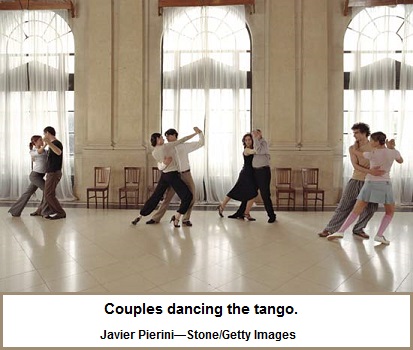
Even though physics sports the idea of having three families of fundamental particles (Stable- Unstable- Highly Unstable), along with the idea of 3 Quarks and 3 Anti-Quarks, not to mention the 3-to-1 of Solids- Liquids- Gases + Plasma; there is a recurring reliance on using "two" such as in the two-slit experiment to determine if an Electron is a wave or particle, and the "two" as a bare minimum in calculating atomic particle interaction. The idea of Quantum Mechanics or behavior of (a) quantity is sometimes used as an analogy when one attempts to grapple with a context where interactions amongst numerous insects, people or other life-form activity occurs. In short, Quantum Mechanics is a model. But instead of looking at the overall interaction of people in a nation, the planet or a small city, we can view the interactions on a dance floor as an expression of Quantum Mechanics. For example, the old expression "it takes two to tango" could mean one's repertoire of dancing is extremely limited, or that the tango was chosen because it satisfies the basic minimum of a biasness for "two". No doubt the expression more rightly developed, as a later after-thought, at a time with the tango was a wide-spread accepted social behavior. Generally speaking, dancing is a social expression of quantum mechanics on the macroscopic level. Different dances reflect different types of interaction involving different colors (of costumes, garments, etc.), different personalities of spin characteristics, and the different flavorings of the space such interactions take place... all of which are attributes coined to reflect the different perspectives of physicists.

Dancing in pairs, like providing a basic equation, is a well known construct of thinking, though the two are not commonly sighted as such. Whereas one person may dance by themselves, we typically do not see three, four, five, six or so... people dancing together. In other words, the numerical distinctions beyond two are not a regularity that have developed into a common perception. Though the occasion of one person dancing alone, particularly in some theatrical exposition, and the recurring two-person custom are readily known, beyond the quantity "two" we might want to collectively say the word "many". The "one- two- many" designation is akin to the development of recognizing quantity in the history of humanity's grasp and usage of labeled numerical values. The Pythagorean "music of the spheres" takes on a different notion when we assess it from the stand point of viewing the presence of music and the overall spherical gyrations involved in dancing... with a group viewed as a conglomeration of planetary bodies... noting that some of these social bodies do indeed rotate like a planetary system such as in the case of square-dancing.
Though some dance routines are highly stylized and choreographed to a point of being a repetitive schematic, others are said to be more improvisational... based on a person's own interpretation of sounds and feelings in a given context, such as tap dancing, though typically performed as a solo, might include a partner as was the case Fred Astaire and Ginger Rogers whose routines included tap, ballroom and popular dance intricacies. (It has been said he was a consummate perfectionist.)
 |
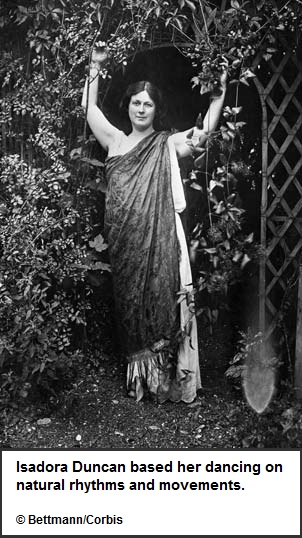 |
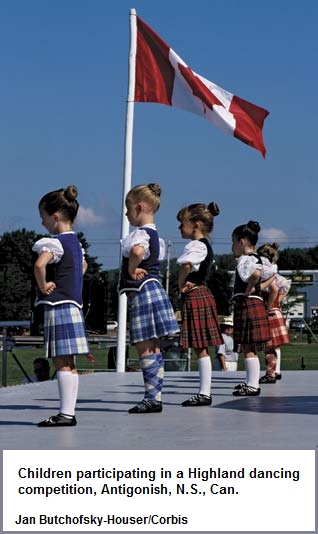 |
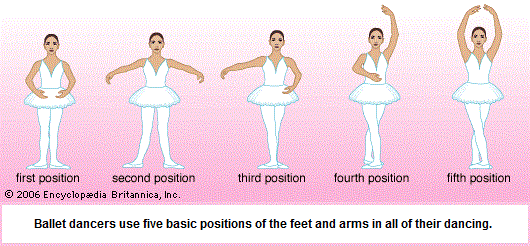 | ||
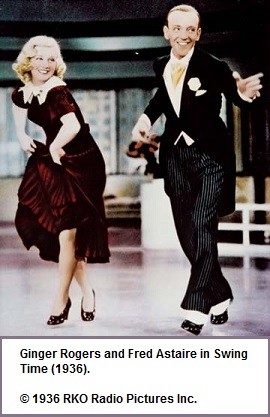 |
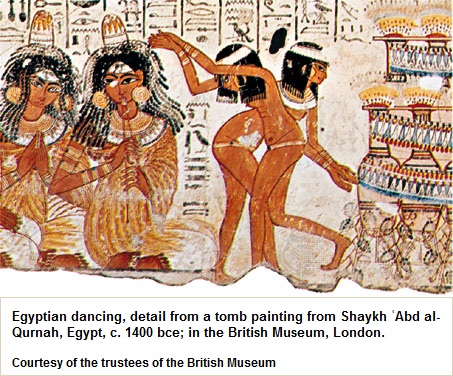 |
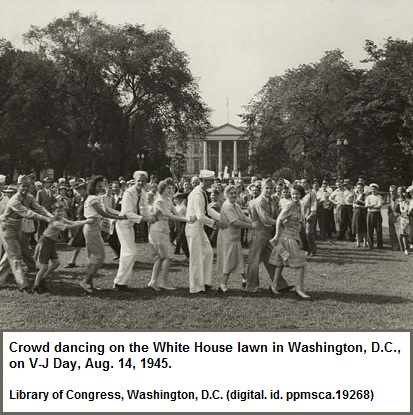 |
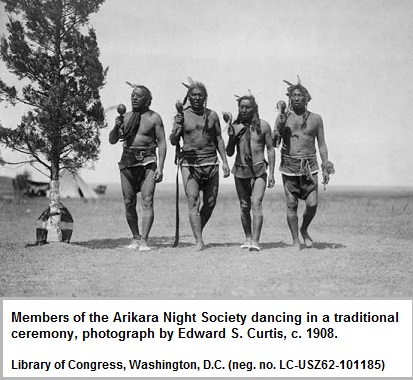 |
No doubt one or another reader might come across a picture detailing a dance which involved a particularly small quantity of dancers as a common routine, but such instances are not customarily thought of in some circumstances. One's references would no doubt reflect one's culture, one's interest, or one's knowledge of dance routines. In the above image of the Arikara tribesmen engaged in a "dance", the quantity of four-persons may have been related to the sacred number 4 found to be characteristic of many different Native American tribes, though the number five is said to have been a sacred number as well. However, it is not known whether the old observances of practice have been continued into the present, since time and interpretation of past rituals can change... just like the interpretations of a Constitution and the resulting social practices. In terms of social practices and dancing, it has been noted that honey bees use a type of "dance" describing socially useful interests such as the direction and distance of food. The so-called dances are defined as a communication system. Interestingly, when we humans describe the interactive structure of both honeybees and termites, we refer to them with such terms as caste, colony and society; as well as assign a three-class system characteristic of that noted by historians when they refer to Indo-European societies having the three orders of... those who pray, those who fight, those who work. (AI and 3sology pg18) In the realm of termites the three divisions of "labor" are noted as the Reproductives, Soldiers, and workers; while in honeybees the divisions are worker, queen and drone.
 |
 |
While some people prefer to compare quantum behavior with playing pool (or billiards), tennis (or table tennis), badminton, volley ball, croquet, etc., many tend to overlook the commonality of practicing a back-and-forth swinging motion of play between two opponents set out on a diagrammed field or placement of goals, and a particular sequence in which scores may be increased (with or without penalty). In other words, there are artificially created rules to define and determine whether a sought after binary result has been achieved, despite the (subtle) allusions to three-patterned formulas such as two teams and one referee, umpire, judge, etc...
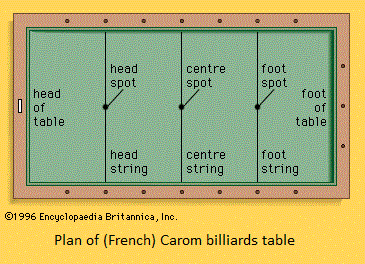 |
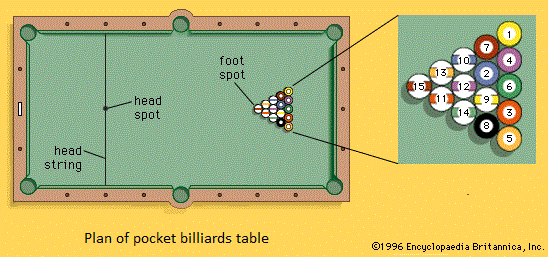 |
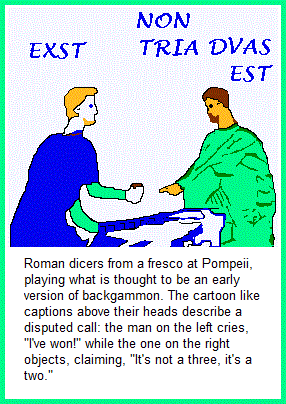
While quantum mechanical equations may use the minimum of two particles as an illustration, in the case of many sports contests, there may be a single particle (as a ball or shuttlecock), that must interact between two points of opposition (two players or two teams). In the case of tarbet shooting with a bow and arrows or a firearm, the bullet or arrow becomes the accelerated particle between a person and their target. In the case of a moving vehicle and a person headed towards a destination, the person themselves participates as an observer on the particle (vehicle) and (usually) prevents a collision with the point of destination... or some other particle driven by someone else. In other words, sports shows us that a binary situation has somewhat transitioned to the usage of a trinary accompaniment. It is a circumstance seen in the three-patterned Paper- Rock- Scissors betting game, though such three-patterned schemes can be seen having occurred over long expanses of time such as in the usage of three different types of archery bows as an historical practice.
The image to the right describes an old game detailing a disputed call, that we can use as an analogy to the attributes of the left and right hemispheres of the brain. It is because of the intellectual solidification of the "two" in the form of a binary (computer) formula which numerous people are engage with, that a solidification of a trinary presence can be made and contrasted. This reference is being made with regards to the information on: AI and 3sology pg2. Again, related patterns-of-two and/or patterns-of-three do not have to occur in the same time or place. For example, the usage of archery bows appears to revolve around the usage of three different models:
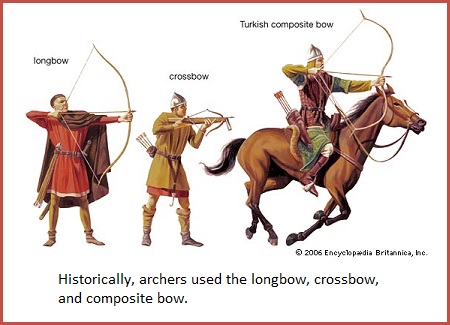
And while many people may not view horse racing in terms of quantum behavior on the macroscopic level, it is of interest to note that all (horse) Thoroughbreds are said to descend from three “Oriental” stallions (the Darley Arabian, the Godolphin Barb, and the Byerly Turk, all brought to Great Britain, 1690–1730); and that these were survived by Matchem, King Herod and Eclipse.
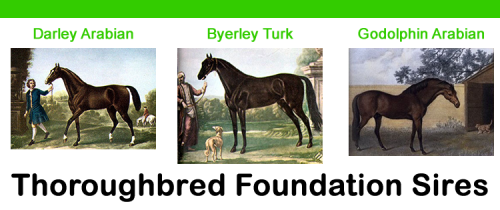 The three foundation stallions were first brought to England from the Mediterranean Middle East in the seventeenth century. These sires got their names from their owners, Thomas Darley, Lord Godolphin, and Captain Robert Byerley. Source: Equine Gateway.com |
 Sources: (Wikipedia references): Matchem Herod Eclipse |
Quantum behavior is a code. But the behavior of a single atomic particle would be a code, or at least rendered in a code called mathematics or language. The means by which we would implement in order to detect behavior would also be a code of experimentation. Nature, and the life of humans are filled with codes... or some type of code is used to describe that which we think we see. We make up codes... (i.e.) languages, as a means of describing something we not only want to convey, but want others to observe and mimic, as if to mimic a call of the wild. For example, we use UPCs (Universal Product Codes) for retail items, social security numbers as codes of identification, driver's licenses, business licenses, marriage licenses, as well as birth and death certificates... as different types of social codes, as codes of social law to be observed and respected. We also have various honor codes, codes of conduct and the codes sprouted by military chevrons, ribbons and types of uniform. Street signs, facial and hand gestures and numerous other human activities (jewelry, perfume, bathing, sunglasses, gloves, corsages, ceremonies) are codes, though we may use the word "sign", routine, habit, apparel, etc., instead. And let us not fail to mention badges of employment such as those worn by police and fire personnel, though some people prefer to wear particular clothing in a particular way or a certain hair style as social badges of distinction as expressed social codes to be recognized and perhaps identified with; though others prefer facial expressions and body language as codes to be shown.
On different occasions because of one or another instance where the desired item is not available or difficult to use under a given situation, we might substitute a convention with yet another convention such as using as using lines in a manner to express color, such as in the case of a family shield or crest:
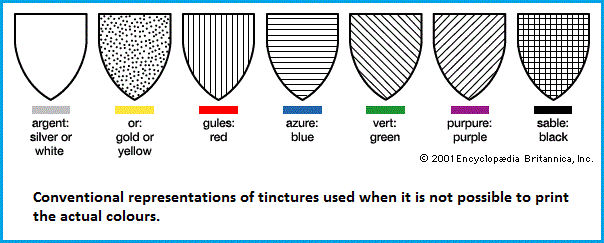
We use codes, we use different languages (sounds, gestures, etc...) and symbols because we don't actually know how to express ourselves accurately, with the types of communication existing today. Though some people are interpreted as being able to articulate with great efficiency and accuracy, that to which they are conveying may be little more than one step removed from the expressions used by jungle primates used to convey some simply observation. While we humans of today may greatly admire a person's singing or speaking ability, or another's whistling, yodeling, or acting talent; those of the future, like we of the present looking backward a million years, may necessarily smile and be humored by the primivity of self-expression used to communicate with. And yet, such primivity is the recognized and accepted code of a given time, place and person. It has meaning for many people just as the binary code being used for computers does today. However, such a code is being viewed as the expression of an insect... or lower form of life... and those who recognize such are in search of a more useful system of communication because a human-level artificial intelligence requires a more sophisticated form of language... a code more definitive of that which it is being called upon to be used. For example, a doublet code in genetics would not be sufficient for the development of a human established by a triplet code.
It is better that we interpret the codes, languages and symbols presently being used, are trial and effort exercises in trying to both witness and express a greater level of truth... with certainty... and yet keep it secret. Secrecy is obtained if not through a jargon, then by way of complicating the expression by way of symbols that may or may not be accompanied by ritualized social customs. When a code becomes too well known, someone tries to create one that is less understood... and thus suggests itself as something unique, secret and meant for only a few who can impress themselves with a notion of specialness. People like to keep secrets and will lie to do so... because keeping secrets enables a person to be kept from being exploited... but also enables exploiters a means of developing a system of communication amongst themselves, if they are also enabled with the ability to establish laws that maintain their perspective as that to be socially observed and practiced as a standard.
Very often in using codes, we humans attach some number-symbol correlation, or analogy, thus presenting us with a system of analog. While a number-symbol may be used, that to which it describes does not typically represent a quantity. Hence, though we may describe the turning on of a light switch as being represented by the number-symbol "1", the value of "1" as a quantitative measure is not being employed. Such a situation is made clearer by using the number-symbol "0" to represent the "off" position of a light switch or electrical circuit. Because the "off" of a switch actually describes a single moment when contrasted to a single "on" moment, the symbols "1" and "O" are being used as distinctions which attempt to discard them of any personality such as quantitative value. And such an idea such likewise be considered when discussing the triplet coding system of genetics, because genetics is being used as a possible alternative for developing a different type of computation for an enhanced form of computer design.
Subject page first Originated (saved into a folder): Thursday, November 13, 2014... 5:50 AM
Page re-Originated: Sunday, 24-Jan-2016... 08:51 AM
Initial Posting: Saturday, 13-Feb-2016... 10:59 AM
Updated Posting: Tuesday, 25-June-2019... 2:57 PM
Herb O. Buckland
herbobuckland@hotmail.com